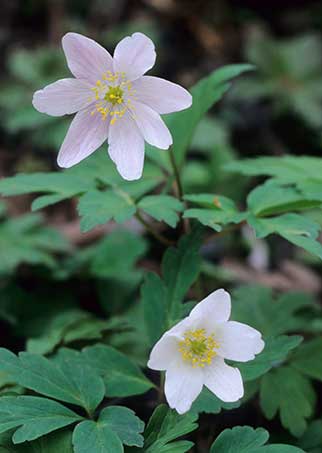Wood anemone (Anemone nemorosa)
When: March - May
How many: Fairly widespread but thinly distributed

Whilst abundant in suitable habitat elsewhere, wood anemones occur sparingly in the New Forest woodlands - they are palatable plants for commoners’ stock, and deer, and are freely taken.
Elegant, erect perennials, and members of the buttercup family, wood anemones grow to a maximum height of around 25 centimetres (10 inches), but are often considerably shorter. Three-lobed, toothed wood anemone leaves are borne in whorls of three, mid-way up the slender stems whilst the delicate white flowers, sometimes tinged with pink or purple, occur singly on each stem. Prominent yellow-tipped stamens contrast nicely with the adjacent paler colours.
Wood anemone flowers appear early – often in March – so that the plant can flourish before the trees come into leaf, reducing light levels reaching the woodland floor.
Wood anemones are characteristic indicators of ancient woodland, perhaps flourishing best in old, actively managed hazel coppices where they grow well in the years of light just after the hazels have been cut, and also benefit from the intervening darker periods which help suppress growth of tall, rank grasses that otherwise would shade them out.
Sadly, though, as coppicing has declined, so the abundance of wood anemones has reduced, but at least the seeds are able to lie dormant in the ground for many years, awaiting the return of suitable growing conditions.
The Greeks knew wood anemones as Daughters-of-the-Wind - the writer Pliny rather implausibly suggested that ‘Wood anemone flowers never open but when the wind is blowing’. Nicolas Culpeper, the 17th century astrologer/physician, certainly doubted the accuracy of this statement, quoting it, but saying ‘Pliny is my author; if it be not so, blame him.’
Indeed, as evening falls and when the weather is poor, wood anemone stems droop, and flowers close tightly shut, protecting from cold and damp the precious pollen and nectar stashed within - country folk of old concluded that woodland fairies nestled within the curled-up petals, having first pulled the curtains around themselves.
Culpeper suggested many wood anemone virtues, saying: ‘The leaves … being boiled and the decoction drank. The body being bathed with the decoction of them, cures the leprosy: the leaves being stamped, and the juice snuffed up the nose, purgeth the head mightily; so doth the root, being chewed in the mouth, for it procureth much spitting, and bringeth away many watery and phlegmatic humors, and is therefore excellent for the lethargy……’
W.T. Fernie in the late 19th century to some extent agreed with Culpeper, noting of wood anemones: ‘A tincture is made with spirit of wine from the entire plant, collected when in flower. This tincture is remarkably beneficial in disorders of the mucous membranes, alike of the respiratory and of the digestive passages.’ He then, intriguingly, added: ‘As a medicine it best suits persons of a mild, gentle disposition, and of lymphatic constitution, especially females; it is less appropriate for quick, excitable, energetic men’.
The standard variety of wood anemone is popular as a plant of shaded gardens, as is a cultivated form Robinsoniana, which is altogether larger, with attractive lavender-blue flowers.
References:
The Wild Flowers of Britain and Northern Europe: Richard Fitter, Alastair Fitter and Marjorie Blamey
Reader’s Digest Field Guide to the Wild Flowers of Britain
The Encyclopedia of British Wild Flowers: John Akeroyd
The Englishman’s Flora: Geoffrey Grigson
Culpeper’s Complete Herbal, and English Physician: Nicholas Culpeper
Herbal Simples Approved for Modern uses of Cure: W.T. Fernie
More links
Other related links
Search this site

Sadly, 58 animals were killed - 35 ponies, 13 cows, 8 donkeys and 2 sheep, whilst a further 32 were injured - 3 pigs, 9 donkeys, 11 cows and 9 ponies.
(Forty-three accidents occurred in daylight, 15 at twilight and 101 in the dark. Twenty-seven accidents were not reported by the driver involved).
Here's just one horrific example - Three donkeys killed in collision with van at notorious New Forest blackspot (Advertiser and Times)

